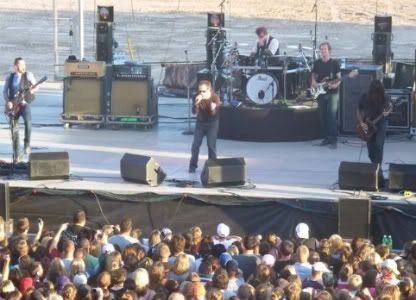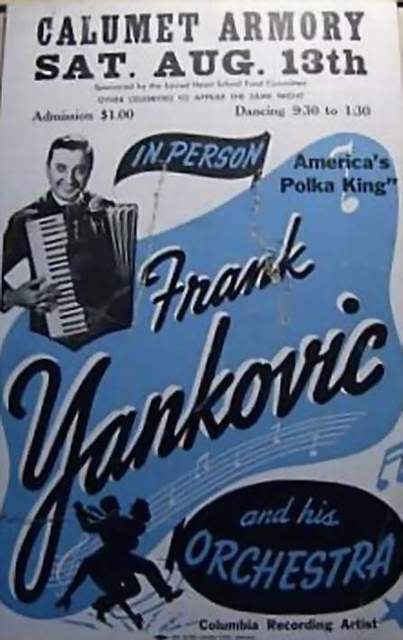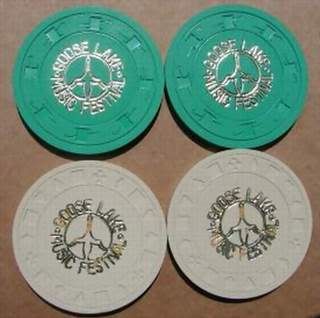
Rolling Stone No.1
By STEVE SEYMOUR
When I received a complementary copy of Rolling Stone in the mail the other day, it reminded me of how important the magazine was to me for decades.
That's because I enjoy reading about rock 'n' roll almost as much as listening to it and the San Francisco-based periodical was an important component in that equation, beginning in the late 1960s.
Rolling Stone No. 1 carried a date of Nov. 9, 1967 and featured a cover photo of John Lennon as Private Gripweed from the film "How I Won the War" as well as stories about the Beatles, Byrds, Donovan, Jimi Hendrix and Eric Clapton.
Founded by Jann S. Wenner and veteran music critic Ralph J. Gleason, Rolling Stone was part newspaper and part magazine, but far from the slick publication it is today.
Selling for 25 cents, Rolling Stone was a tabloid in size, but was folded a second time to take less space on newstands. Publisher Wenner was young rock entrepreneur who saw a future in chronicling the emerging rock 'n' roll scene, while Gleason was a 50-year-old journalist who wrote eloquently about the music he loved in an on-going column called Perspectives.
"Rolling Stone is not just about music, but also about the things and attitudes that the music embraces. We've been working quite hard on it and we hope you can dig it," the 21-year-old Wenner wrote in a letter from the editor inside the debut issue, just 24 pages in length.
The editorial and business offices for the magazine were located at 746 Brannan St. in San Francisco, the city which was home to many of the groups the magazine covered, such as the Grateful Dead, Jefferson Airplane and Country Joe and the Fish.
Early on, Rolling Stone was grouped with the underground newspapers of the era and reported extensively on the hippie counter-culture largely ignored by the mainstream press.
The magazine grew steadily in pages and influence as the the 1960s turned into the 1970s.
Editor Wenner even snagged an extensive interview with John Lennon not long after the break-up of the Beatles, the greatest rock 'n' roll band of the time. Lennon agreed to the project on the premise that the material wouldn't be released in book form. 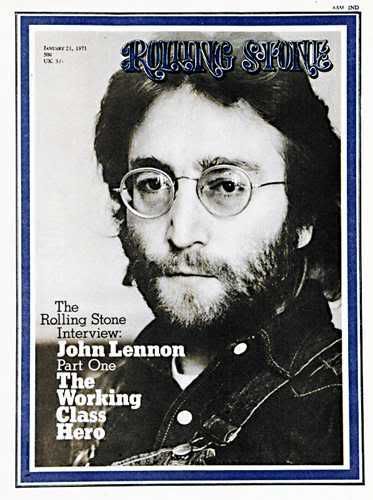
John Lennon gave Rolling Stone a
lengthy interview in late 1970, the first
half of which appeared in issue No. 74.
Lennon's lengthy question and answer sessions were published in Rolling Stone over two editions: No. 74 (Jan. 21, 1971), and No. 75 (Feb. 4, 1971). I eagerly read Lennon's candid interview which detailed his Beatle years and burgeoning solo career.
The interview was conducted over several days in early December in New York City, with Yoko Ono, Lennon's wife, also participating. Titled "Working Class Hero" after a Lennon song, the subsequent articles were incredibly detailed and included photographs of the couple taken by Annie Leibovitz. Later, however, Wenner reneged on his promise and published the interview in a book, "Lennon Remembers." Lennon was upset with this betrayal and didn't speak to Wenner again for years.
Hooked by the Lennon issues, I purchased Rolling Stone off newstands every two weeks for years. During 1972, the magazine produced extensive presidential election coverage and introduced readers to gonzo journalist Hunter S. Thompson. His series, Fear and Loathing in Las Vegas, was later turned into a feature film.
Democratic presidential nominee George McGovern told Rolling Stone, "I stake my hopes in 1972 in large portion on the energy, the wisdom and the conscience of young Americans." His comments appeared in a cover story in issue No. 110, dated June 8, 1972. 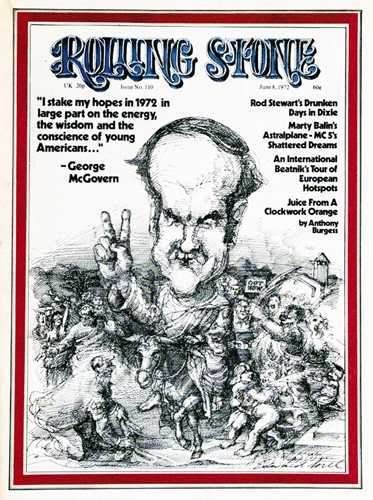
Sen. George McGovern actively sought
the youth vote during his run
for the presidency in 1972. A
caricature of the Democratic nominee
appeared on the cover of Rolling Stone,
issue No. 110.
Spurred on by change seemly promised in the pages of Rolling Stone, I waited in line on the campus of Central Michigan University for hours on Nov. 7 to vote for McGovern. Still, incumbent Richard Nixon won a second tern by promising to end the divisive Vietnam War while tagging McGovern as a radical.
About 1973, I decided to subscribe and let the mailman deliver my favorite periodical to me. A year-long subscription cost $12.
By this time, Rolling Stone looked more like a traditional magazine, although it was still published on newsprint. With the slogan, "All the News That Fits," Rolling Stone had found its audience.
I devoured every issue. Like thousands of other readers the first thing I turned to was the letters to the editor page titled Correspondence, Love Letters & Advice. There, readers offered opinions and their most pithy comments about current affairs. Perhaps two dozen letters were published in each issue. I wrote an earnest letter circa 1973 which was published to my delight, although today I can't recall the topic.
Another popular feature was the Random Notes section, where brief music news items were posted. The News & Opinion section featured serious pieces, often accompanied by the distinctive ink drawings of artist Ralph Steadman. Other noteworthy sections included National Affairs and Rock and Roll. Records were critiqued toward the end of each issue and reviewers often impacted sales of any given album.
And, of course, there were the feature articles, mostly about contemporary musicians. I learned about Cream, Crosby, Stills, Nash & Young, the Doors, Bob Dylan, Janis Joplin, the Mother of Invention, Otis Redding, the Rolling Stones, Sly & the Family Stone, Traffic, and the Who. Together with the music, Rolling Stone offered an education in rock 'n' roll.
One of of the magazine's most-memorable (and heartbreaking) issues was No. 335, dated Jan. 22, 1981. Then, Rolling Stone featured exhaustive coverage of the life and death of John Lennon, following his shocking assassination on Dec. 8, 1980, just days after he had released a new album. Lennon had been working with Rolling Stone writer Jonathan Cott on a cover story marking the ex-Beatle's return to public life after spending five years as a "house-husband."
Because every issue was crammed with such great material, I never wanted to throw old copies away. I just stacked them in the corner. My pile of magazines got bigger and bigger, as the years passed.
By the early 1990s Rolling Stone's management decided to go after a younger demographic. Content turned superficial, serious subjects were dropped and celebrities ruled, much like a supermarket rag. I let my subscription expire.
With my old magazines just gathering dust, I decided to get rid of them during a spring house-cleaning binge a couple of years ago. They found a new home with my friend and fellow rock 'n' roll enthusiast Rod Maynard of Gladstone. Struck by inspiration, he used the magazines to illustrate a video he made for You Tube utilizing the song "The Cover of Rolling Stone" by Dr. Hook & The Medicine Show as background music. 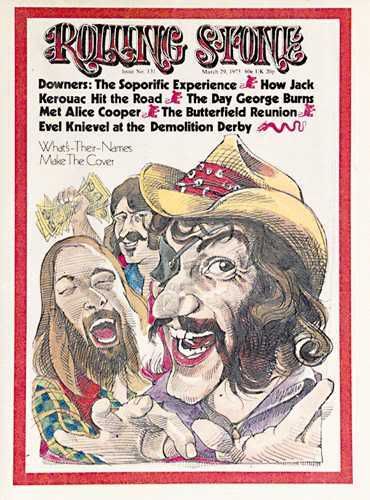
Rock band Dr. Hook & the Medicine
Show found themselves on the front of issue
No. 131 after their song, "The Cover of
Rolling Stone," became a hit.
At the time of this writing, the video has been viewed 168,116 times. (To see it for yourself, go to You Tube, type in yendor61 and scroll down to: Dr. Hook...Cover of Rolling Stone.) Dr. Hook's dream came true on Mar. 29, 1973 when they made the cover of issue No. 131.
Meanwhile, the free issue I found in my mailbox recently was No. 1059 and featured Hollywood rebel Robert Downey Jr. on the cover. Flipping through the pages revealed stories on national affairs, politics and rock 'n' roll, among other topics. By mailing me a complementary copy the folks at Rolling Stone were pointing out that they have returned to the editorial mix which proved so successful in the past.
Maybe it's time for me to start stacking up Rolling Stone magazines again.


